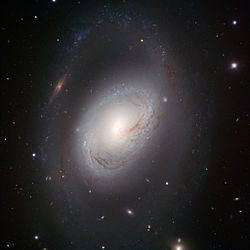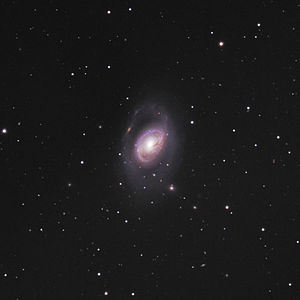- Messier 96
-
Messier 96 
ESO's Very Large Telescope image of Messier 96, also known as NGC 3368. It shows its core displaced from the centre, its gas and dust are distributed asymmetrically and its spiral arms are ill-defined.Observation data (J2000 epoch) Constellation Leo Right ascension 10h 46m 45.7s[1] Declination +11° 49′ 12″[1] Redshift 897 ± 4 km/s[1] Distance 31 ± 3 Mly (9.6 ± 1.0 Mpc)[2] Type SAB(rs)ab[1] Apparent dimensions (V) 7′.6 × 5′.2[1] Apparent magnitude (V) +10.1[1] Other designations NGC 3368,[1] UGC 5882,[1] PGC 32192[1] See also: Galaxy, List of galaxies Messier 96 (also known as NGC 3368) is an intermediate spiral galaxy about 31 million light-years away in the constellation Leo. It was discovered by Pierre Méchain in 1781.
M96 Group
M96 is the brightest galaxy within the M96 Group, a group of galaxies in the constellation Leo also includes the Messier objects M95 and M105, as well as at least nine other galaxies.[3][4][5][6] The M96 galaxy has asymmetric arms and a displaced core, probably caused by the gravitational pull by the other nearby galaxies.
References
- ^ a b c d e f g h i "NASA/IPAC Extragalactic Database". Results for NGC 3368. http://nedwww.ipac.caltech.edu/. Retrieved 2006-10-24.
- ^ Jensen, Joseph B.; Tonry, John L.; Barris, Brian J.; Thompson, Rodger I.; Liu, Michael C.; Rieke, Marcia J.; Ajhar, Edward A.; Blakeslee, John P. (2003). "Measuring Distances and Probing the Unresolved Stellar Populations of Galaxies Using Infrared Surface Brightness Fluctuations". Astrophysical Journal 583 (2): 712–726. arXiv:astro-ph/0210129. Bibcode 2003ApJ...583..712J. doi:10.1086/345430.
- ^ Nearby Galaxies Catalog. Cambridge University Press. 1988. ISBN 0-521-35299-1.
- ^ P. Fouque, E. Gourgoulhon, P. Chamaraux, G. Paturel (1992). "Groups of galaxies within 80 Mpc. II - The catalogue of groups and group members". Astronomy and Astrophysics Supplement 93: 211–233. Bibcode 1992A&AS...93..211F.
- ^ A. Garcia (1993). "General study of group membership. II - Determination of nearby groups". Astronomy and Astrophysics Supplement 100: 47–90. Bibcode 1993A&AS..100...47G.
- ^ G. Giuricin, C. Marinoni, L. Ceriani, A. Pisani (2000). "Nearby Optical Galaxies: Selection of the Sample and Identification of Groups". Astrophysical Journal 543 (1): 178–194. arXiv:astro-ph/0001140. Bibcode 2000ApJ...543..178G. doi:10.1086/317070.
External links
- NOAO: M96
- SEDS: Spiral Galaxy M96
- Messier 96 on WikiSky: DSS2, SDSS, GALEX, IRAS, Hydrogen α, X-Ray, Astrophoto, Sky Map, Articles and images
Coordinates:
 10h 46m 45.7s, +11° 49′ 12″
10h 46m 45.7s, +11° 49′ 12″Messier objects List M1 · M2 · M3 · M4 · M5 · M6 · M7 · M8 · M9 · M10 · M11 · M12 · M13 · M14 · M15 · M16 · M17 · M18 · M19 · M20 · M21 · M22 · M23 · M24 · M25 · M26 · M27 · M28 · M29 · M30 · M31 · M32 · M33 · M34 · M35 · M36 · M37 · M38 · M39 · M40 · M41 · M42 · M43 · M44 · M45 · M46 · M47 · M48 · M49 · M50 · M51 · M52 · M53 · M54 · M55 · M56 · M57 · M58 · M59 · M60 · M61 · M62 · M63 · M64 · M65 · M66 · M67 · M68 · M69 · M70 · M71 · M72 · M73 · M74 · M75 · M76 · M77 · M78 · M79 · M80 · M81 · M82 · M83 · M84 · M85 · M86 · M87 · M88 · M89 · M90 · M91 · M92 · M93 · M94 · M95 · M96 · M97 · M98 · M99 · M100 · M101 · M102 · M103 · M104 · M105 · M106 · M107 · M108 · M109 · M110See also  Book:Messier objects ·
Book:Messier objects ·  Category:Messier objects
Category:Messier objects  Portal:AstronomyCategories:
Portal:AstronomyCategories:- Spiral galaxies
- Intermediate spiral galaxies
- M96 Group
- Leo constellation
- Messier objects
- NGC objects
- UGC objects
- PGC objects
Wikimedia Foundation. 2010.

